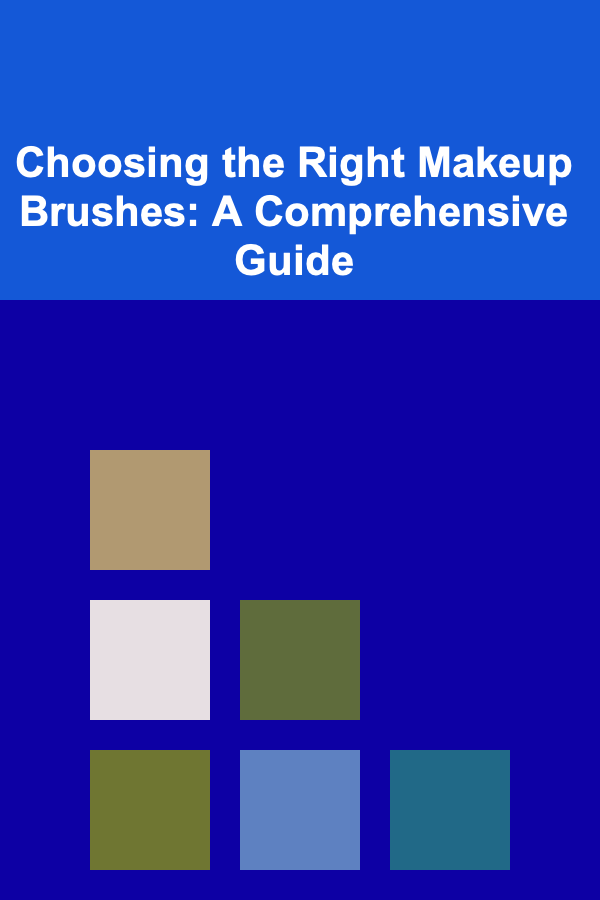
Choosing the Right Makeup Brushes: A Comprehensive Guide
ebook include PDF & Audio bundle (Micro Guide)
$12.99$9.99
Limited Time Offer! Order within the next:

Achieving a flawless makeup look is an art form, and like any art, the tools you use are crucial. While high-quality makeup is essential, even the best products can fall short if applied with the wrong brushes. The right makeup brushes can blend seamlessly, build coverage effectively, and precisely apply product, ultimately elevating your makeup game. This comprehensive guide delves into the world of makeup brushes, covering everything from brush types and materials to selection criteria and proper maintenance, empowering you to make informed decisions and create stunning looks.
Understanding Makeup Brush Basics
Before diving into specific brushes, it's important to grasp the fundamental components and characteristics that define a makeup brush.
Brush Head: Shape, Size, and Bristle Type
The brush head is the business end, responsible for picking up and depositing makeup. Its shape, size, and bristle type directly influence the brush's performance.
- Shape: Brush head shapes vary widely, including round, tapered, flat, angled, and fan-shaped. Each shape is designed for specific applications. For example, a round brush is excellent for blending, while an angled brush is ideal for precise eyeliner.
- Size: Larger brushes cover more surface area quickly, making them suitable for applying foundation or powder. Smaller brushes offer greater precision for detail work like eyeshadow application or concealer placement.
- Bristle Type: Bristles are made from either natural or synthetic materials, each with its unique properties.
Natural vs. Synthetic Bristles: Making the Right Choice
The choice between natural and synthetic bristles depends largely on the type of makeup you're using and your personal preferences.
Natural Bristles
Natural bristles, typically derived from animal hair (e.g., goat, squirrel, pony), have a cuticle layer, similar to human hair. This cuticle creates microscopic pockets that pick up and hold powdered products exceptionally well. This makes them ideal for:
- Powder-based products: Eyeshadows, blush, bronzer, and setting powder are best applied with natural brushes because they blend effortlessly and distribute pigment evenly.
- Building coverage: The textured surface of natural bristles allows for gradual building of color, preventing a heavy or cakey look.
- Soft and seamless blending: Natural brushes are known for their soft feel against the skin and their ability to create a diffused, airbrushed finish.
However, natural bristles have some drawbacks:
- Porosity: Their porous nature makes them more absorbent, potentially trapping bacteria and requiring more frequent and thorough cleaning.
- Fragility: Natural bristles can be more delicate than synthetic fibers and may shed or fray over time if not properly cared for.
- Cost: High-quality natural brushes are often more expensive than their synthetic counterparts.
- Ethical Concerns: Sourcing of animal hair for brushes can raise ethical considerations. Look for brands that prioritize responsible sourcing practices.
- Not Ideal for Liquids/Creams: They tend to absorb liquid and cream products, making them difficult to clean and potentially leading to product waste.
Synthetic Bristles
Synthetic bristles are made from man-made materials such as nylon or taklon. They are smooth and non-porous, making them perfect for:
- Liquid and cream products: Foundation, concealer, cream blush, and liquid eyeliner glide smoothly over synthetic bristles without being absorbed, resulting in even application and minimal product waste.
- Hygiene: Synthetic bristles are less prone to harboring bacteria due to their non-porous nature, making them easier to clean and more hygienic.
- Durability: Synthetic brushes are generally more durable and resistant to shedding than natural brushes.
- Affordability: Synthetic brushes are often more budget-friendly than natural brushes, making them a great option for beginners or those on a tight budget.
- Vegan-Friendly: Synthetic brushes are a cruelty-free alternative for those who prefer to avoid animal products.
However, synthetic bristles may not always blend powders as seamlessly as natural bristles. Some synthetic brushes can feel stiffer than natural brushes, although advances in technology have led to the development of incredibly soft and high-quality synthetic options.
The Ferrule and Handle: Construction and Ergonomics
The ferrule is the metal part that connects the bristles to the handle. It should be securely crimped to prevent shedding and ensure the longevity of the brush. The handle should be comfortable to hold and provide good control during application. Ergonomic handles can make a noticeable difference, especially for those who spend a lot of time applying makeup.
Essential Makeup Brushes: A Comprehensive Guide by Product Type
Now, let's explore the specific brushes recommended for different makeup products.
Foundation Brushes: Achieving a Flawless Base
Foundation is the cornerstone of most makeup looks, and the right brush can make a world of difference in achieving a smooth, even complexion.
- Flat Foundation Brush: This classic brush features a flat, paddle-shaped head with densely packed synthetic bristles. It's best for applying liquid or cream foundation for buildable coverage. Use it to stipple (press) the foundation onto the skin and then blend with short, even strokes. While effective, it can sometimes leave streaks if not blended thoroughly.
- Round Foundation Brush (Buffing Brush): With its rounded, dense head, this brush is designed for buffing foundation into the skin for a seamless, airbrushed finish. It works well with liquid, cream, and even some powder foundations. Use it in circular motions to blend the foundation evenly, minimizing streaks and creating a natural-looking base.
- Stippling Brush (Duo Fibre Brush): This brush has two layers of bristles: a shorter, denser layer at the base and a longer, more sparse layer at the top. This unique design allows you to stipple foundation onto the skin for light to medium coverage. It's particularly good for achieving a natural, dewy look.
- Angled Foundation Brush: An angled foundation brush allows for precise application around the nose, under the eyes, and in other hard-to-reach areas. Ideal for cream and liquid foundations.
- Beauty Sponge (Not Technically a Brush): While not a brush, a damp beauty sponge is a popular alternative for applying foundation. It provides light to medium coverage and creates a dewy, natural finish. Make sure to use a stippling or bouncing motion rather than dragging the sponge across the skin.
Brush Material Recommendation: Synthetic bristles are ideal for foundation brushes due to their compatibility with liquid and cream formulas and their ease of cleaning.
Concealer Brushes: Spot-On Coverage
Concealer brushes are designed for precise application and blending of concealer, helping to cover blemishes, dark circles, and other imperfections.
- Small, Flat Concealer Brush: This brush is perfect for applying concealer to small, targeted areas, such as blemishes or dark spots. Its flat shape allows for precise placement and even coverage.
- Tapered Concealer Brush: The tapered shape of this brush makes it ideal for blending concealer under the eyes and around the nose. The pointed tip allows for reaching the inner corners of the eyes with ease.
- Buffing Concealer Brush: Similar to a round foundation brush, a buffing concealer brush has a dense, rounded head that's perfect for buffing concealer into the skin for a seamless, natural finish.
Brush Material Recommendation: Synthetic bristles are preferred for concealer brushes, as they work well with both cream and liquid concealers and are easy to clean.
Powder Brushes: Setting and Finishing
Powder brushes are used to apply loose or pressed powder, setting foundation and concealer, and creating a smooth, matte finish.
- Large Powder Brush: This fluffy brush is ideal for applying setting powder all over the face. Its large size allows for quick and even distribution of powder.
- Tapered Powder Brush: A tapered powder brush provides more precise application, making it suitable for setting specific areas, such as under the eyes or around the nose.
- Kabuki Brush: Kabuki brushes are known for their dense, tightly packed bristles and short handles. They can be used to apply powder foundation, setting powder, or bronzer for a full-coverage, polished look.
Brush Material Recommendation: Natural bristles are often preferred for powder brushes because they pick up and distribute powder evenly, creating a soft, diffused finish. However, high-quality synthetic options are also available.
Blush Brushes: Adding a Flush of Color
Blush brushes are designed to apply blush to the apples of the cheeks, adding a healthy flush of color.
- Angled Blush Brush: The angled shape of this brush fits perfectly along the cheekbones, making it easy to contour and apply blush with precision.
- Round Blush Brush: A round blush brush provides a softer, more diffused application of blush. It's ideal for creating a natural-looking flush of color.
- Tapered Blush Brush: Similar to the angled blush brush, but with a softer edge, providing controlled application and blending.
Brush Material Recommendation: Natural bristles are generally preferred for blush brushes, as they pick up and distribute powder blush evenly, creating a natural, blended finish. However, high-quality synthetic options are also suitable.
Bronzer Brushes: Creating a Sun-Kissed Glow
Bronzer brushes are used to apply bronzer to the face, adding warmth and dimension.
- Large, Fluffy Bronzer Brush: This brush is ideal for applying bronzer to the forehead, cheekbones, and jawline, creating a sun-kissed glow.
- Angled Bronzer Brush: An angled bronzer brush allows for more precise contouring, helping to define the cheekbones and sculpt the face.
Brush Material Recommendation: Natural bristles are often preferred for bronzer brushes, as they pick up and distribute powder bronzer evenly, creating a natural, blended finish. However, high-quality synthetic options are also available.
Highlighter Brushes: Illuminating Your Features
Highlighter brushes are used to apply highlighter to the high points of the face, such as the cheekbones, brow bone, and Cupid's bow, adding a luminous glow.
- Tapered Highlighter Brush: The tapered shape of this brush allows for precise application of highlighter to the cheekbones, brow bone, and Cupid's bow.
- Fan Brush: A fan brush provides a very light, diffused application of highlighter, creating a subtle, ethereal glow.
- Small, Tapered Blending Brush: Can be used for more precise placement of highlighter, particularly on the bridge of the nose or inner corner of the eye.
Brush Material Recommendation: Both natural and synthetic bristles can be used for highlighter brushes, depending on the desired intensity. Natural bristles provide a softer, more diffused glow, while synthetic bristles offer more precise application.
Eyeshadow Brushes: Creating Captivating Eye Looks
Eyeshadow brushes are essential for creating a variety of eye looks, from simple washes of color to intricate smoky eyes.
- Flat Eyeshadow Brush (Shader Brush): This brush is used to pack eyeshadow onto the lid, creating a base color or adding intensity.
- Blending Brush: A blending brush is essential for blending eyeshadow seamlessly, creating a smooth transition between colors and preventing harsh lines. Look for a fluffy brush with a rounded or tapered shape.
- Crease Brush: A crease brush is designed to apply eyeshadow to the crease of the eye, adding depth and dimension. Look for a tapered brush that fits comfortably into the crease.
- Pencil Brush: A pencil brush has a small, pointed tip that's perfect for applying eyeshadow to the lower lash line, smudging eyeliner, or highlighting the inner corner of the eye.
- Angled Eyeshadow Brush: An angled eyeshadow brush can be used to create sharp lines and define the outer corner of the eye.
Brush Material Recommendation: Natural bristles are often preferred for eyeshadow brushes because they pick up and blend powder eyeshadows effectively. However, synthetic bristles are a good option for applying cream eyeshadows or for those who prefer cruelty-free options.
Eyeliner Brushes: Defining Your Eyes with Precision
Eyeliner brushes are used to apply eyeliner, creating a defined and dramatic look.
- Angled Eyeliner Brush: This brush is ideal for applying gel or cream eyeliner to the upper lash line, creating a winged or cat-eye effect.
- Fine-Point Eyeliner Brush: A fine-point eyeliner brush allows for precise application of liquid eyeliner, creating a thin, defined line.
- Smudge Brush: Used for softening and smudging eyeliner for a smokey effect.
Brush Material Recommendation: Synthetic bristles are recommended for eyeliner brushes, as they work well with gel, cream, and liquid eyeliners and allow for precise application.
Lip Brushes: Achieving a Perfect Pout
Lip brushes are used to apply lipstick or lip gloss, creating a defined and long-lasting lip look.
- Small, Flat Lip Brush: This brush is ideal for applying lipstick with precision, defining the lip line, and filling in the lips evenly.
Brush Material Recommendation: Synthetic bristles are recommended for lip brushes, as they work well with both cream and liquid lip products and are easy to clean.
Eyebrow Brushes: Sculpting and Defining Your Brows
Eyebrow brushes are used to fill in and shape the eyebrows, creating a polished and defined look.
- Angled Eyebrow Brush: This brush is used to apply eyebrow powder or pomade, filling in sparse areas and defining the brow shape.
- Spoolie Brush: A spoolie brush is used to groom and blend eyebrow products, creating a natural and polished look. Often comes on the other end of an angled eyebrow brush.
Brush Material Recommendation: Synthetic bristles are recommended for eyebrow brushes, as they work well with both powder and pomade products and allow for precise application.
Beyond the Basics: Advanced Brush Selection and Considerations
Once you've mastered the essentials, you can delve into more specialized brushes and considerations for refining your makeup application.
Brush Density: Impact on Pigment Payoff
Brush density refers to how tightly packed the bristles are. Denser brushes pick up and deposit more pigment, offering higher coverage and intensity. Sparsely packed brushes provide a lighter, more diffused application, ideal for blending and layering.
Handle Length and Material: Ergonomics and Control
While often overlooked, handle length and material significantly impact brush control and comfort. Longer handles offer more reach and leverage, while shorter handles provide greater precision. Handle materials range from wood and acrylic to metal and silicone, each offering a different grip and aesthetic.
Budget Considerations: Balancing Quality and Affordability
Makeup brush prices can vary significantly, from budget-friendly sets to high-end individual brushes. While investing in quality brushes is worthwhile, it's possible to find excellent options at different price points. Consider starting with a basic set of essential brushes and gradually adding more specialized ones as needed. Look for sales and discounts to maximize your budget.
Travel Brush Sets: On-the-Go Glamour
For travel, consider investing in a compact brush set that includes essential brushes in a travel-friendly size. These sets often come with a carrying case for easy storage and protection. Look for sets with durable brushes that can withstand frequent travel.
Caring for Your Makeup Brushes: Extending Their Lifespan
Proper care and maintenance are crucial for extending the lifespan of your makeup brushes and ensuring optimal performance. Dirty brushes can harbor bacteria, leading to skin irritation and breakouts. They can also affect the application of your makeup, resulting in a patchy or uneven finish.
Regular Cleaning: Maintaining Hygiene and Performance
Clean your makeup brushes regularly, ideally after each use for brushes used with liquid or cream products and at least once a week for brushes used with powder products. Use a gentle brush cleanser or mild soap and water. Swirl the brush bristles in the cleanser, rinse thoroughly, and gently squeeze out excess water. Reshape the bristles and lay the brush flat to dry. Avoid drying brushes upright, as this can cause water to seep into the ferrule and damage the glue holding the bristles in place.
Deep Cleaning: Removing Stubborn Residue
Every few weeks, give your brushes a deep cleaning to remove stubborn residue and bacteria. Use a brush cleaning mat or textured surface to help dislodge makeup buildup. Consider using a clarifying shampoo for a more thorough cleanse. Ensure the brushes are completely dry before using them again.
Storage: Protecting Your Investment
Store your makeup brushes in a dry, clean place, away from direct sunlight and heat. Use a brush holder or organizer to keep your brushes separated and prevent them from getting damaged. Avoid storing brushes in a damp or humid environment, as this can promote bacterial growth.
Conclusion: The Path to Makeup Mastery
Choosing the right makeup brushes is an investment in your makeup routine and your overall appearance. By understanding the different types of brushes, their materials, and their intended uses, you can select the tools that will help you achieve your desired makeup looks with ease and precision. Remember to prioritize quality, hygiene, and proper maintenance to ensure that your brushes serve you well for years to come. Embrace the art of makeup application and let your brushes be your partners in creating a beautiful and confident you.

How to Design a Kid-Friendly Holiday Decoration Plan
Read More
How to Organize Your BBQ Supplies Efficiently
Read More
How to Set Up a DIY Bar for Your Home Party
Read More
How to Use Home Staging to Make Your Space Feel Larger
Read More
How to Make Your Home Energy Independent
Read More
Finding the Right Therapist for You: A Comprehensive Guide
Read MoreOther Products

How to Design a Kid-Friendly Holiday Decoration Plan
Read More
How to Organize Your BBQ Supplies Efficiently
Read More
How to Set Up a DIY Bar for Your Home Party
Read More
How to Use Home Staging to Make Your Space Feel Larger
Read More
How to Make Your Home Energy Independent
Read More